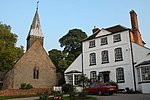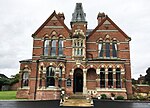The River Lugg (Welsh: Afon Llugwy) rises near Llangynllo in Radnorshire, Wales. It flows through the border town of Presteigne and then through Herefordshire, England, where it meets its main tributary, the River Arrow, to the south of Leominster. It flows into the River Wye downstream of Hereford at Mordiford, around 63 miles (101 km) from its source. Its name comes from a Welsh root, and means "bright stream".As it passes through the countryside, it is crossed by a number of bridges, many of which are listed structures. Lugg Bridge at Lugwardine and the bridge at Mordiford with its associated causeway both date from the 14th century. The river at Leominster was altered significantly in the 1960s, when it was diverted to the south and then along the course of the Leominster and Kington Railway around the northern edge of the town, as part of a flood defence scheme. In the past, it was important for milling, supplying power to nearly one third of the mills in Herefordshire at the time of the Domesday Book. There are a few mills left, and some obvious mill sites, but many of the mills below Leominster were bought up and their weirs demolished as part of a scheme to make the river navigable in the 1690s. This was not a success, as the water levels dropped creating shoals, and in the 1720s, some of the weirs were reinstated, with pound locks to enable boats to bypass them. Navigation up to Leominster was for a time possible, although it was never hugely successful, and ceased in the 1860s, once railways had been built in the area.
The river was a free navigation as a result of powers obtained in an Act of Parliament of 1695, but in 2002, the Environment Agency became the navigation authority following the passing of the Wye Navigation Order. This reaffirmed the right of navigation on the river, but prohibited the building of locks and weirs, and so most boating is by canoes and kayaks. The river is also used for fishing, as it has good populations of wild brown trout and grayling. Water quality of the river system is moderate, although some of its tributaries have poor water quality, and some bad. In common with many rivers, the chemical quality changed from good to fail in 2019, following the introduction of testing for chemicals not previously included in the quality assessment. The whole of the river is a Site of Special Scientific Interest, and since 2003, a policy of building fish passes where there are weirs has led to significant improvements to the presence of migratory fish in the river.








